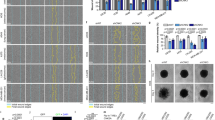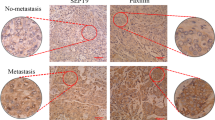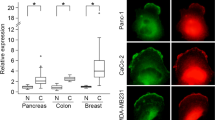Abstract
Invasive cell migration is a key step for cancer metastasis and involves Rho GTPase-controlled reorganization of the actin cytoskeleton. Altered Rho GTPase expression is found in various malignancies. Particularly, the closely related GTPases RhoA and RhoC are upregulated in many aggressive tumours, but specific effectors that distinguish between these two GTPases to explain mechanistic differences have not been identified. The formins are by far the largest family of Rho GTPase effectors and are characterized by the actin-nucleating formin homology 2 domain. Using siRNA-based screening against all 15 human formins, we systematically analysed their functions in 3D cell motility using three different cancer cell lines. These results reveal distinct requirements for specific formins in amoeboid versus mesenchymal invasive cell migration. Importantly, by knocking down all Rho proteins, we identified formin-like 2 (FMNL2) as a specific RhoC effector, showing selective interaction of FMNL2 with active RhoC, but not RhoA or RhoB. Functional analysis shows that RhoC regulates autoinhibition of FMNL2, whereas suppression of FMNL2 inhibits RhoC-, but not RhoA-dependent, rounded invasive cell migration. Thus, our data uncover a novel regulatory and functional interaction between RhoC and FMNL2 for modulating cell shape and invasiveness and provide mechanistic insight into RhoC-specific signalling events.
This is a preview of subscription content, access via your institution
Access options
Subscribe to this journal
Receive 50 print issues and online access
$259.00 per year
only $5.18 per issue
Buy this article
- Purchase on Springer Link
- Instant access to full article PDF
Prices may be subject to local taxes which are calculated during checkout




Similar content being viewed by others
References
Brandt DT, Baarlink C, Kitzing TM, Kremmer E, Ivaska J, Nollau P et al. (2009). SCAI acts as a suppressor of cancer cell invasion through the transcriptional control of beta1-integrin. Nat Cell Biol 11: 557–568.
Chesarone M, Gould CJ, Moseley JB, Goode BL . (2009). Displacement of formins from growing barbed ends by bud14 is critical for actin cable architecture and function. Dev Cell 16: 292–302.
Clark EA, Golub TR, Lander ES, Hynes RO . (2000). Genomic analysis of metastasis reveals an essential role for RhoC. Nature 406: 532–535.
Copeland JW, Treisman R . (2002). The diaphanous-related formin mDia1 controls serum response factor activity through its effects on actin polymerization. Mol Biol Cell 13: 4088–4099.
Fackler OT, Grosse R . (2008). Cell motility through plasma membrane blebbing. J Cell Biol 181: 879–884.
Faix J, Grosse R . (2006). Staying in shape with formins. Dev Cell 10: 693–706.
Fleming Y, Ferguson GJ, Spender LC, Larsson J, Karlsson S, Ozanne B et al. (2009). TGFβ-mediated activation of RhoA signalling is required for efficient V12-H-Ras and V600E-BRaf transformation. Oncogene 28: 983–993.
Goode BL, Eck MJ . (2007). Mechanism and function of formins in the control of actin assembly. Annu Rev Biochem 76: 593–627.
Goulimari P, Kitzing TM, Knieling H, Brandt DT, Offermanns S, Grosse R . (2005). Galpha12/13 is essential for directed cell migration and localized Rho-Dia1 function. J Biol Chem 280: 42242–42251.
Goulimari P, Knieling H, Engel U, Grosse R . (2008). LARG and mDia1 link Galpha12/13 to cell polarity and microtubule dynamics. Mol Biol Cell 19: 30–40.
Grosse R, Copeland JW, Newsome TP, Way M, Treisman R . (2003). A role for VASP in RhoA-Diaphanous signalling to actin dynamics and SRF activity. EMBO J 22: 3050–3061.
Hakem A, Sanchez-Sweatman O, You-Ten A, Duncan G, Wakeham A, Khokha R et al. (2005). RhoC is dispensable for embryogenesis and tumor initiation but essential for metastasis. Genes Dev 19: 1974–1979.
Hill CS, Wynne J, Treisman R . (1995). The Rho family GTPases RhoA, Rac1, and CDC42Hs regulate transcriptional activation by SRF. Cell 81: 1159–1170.
Ji P, Jayapal SR, Lodish HF . (2008). Enucleation of cultured mouse fetal erythroblasts requires Rac GTPases and mDia2. Nat Cell Biol 10: 314–321.
Jones S, Zhang X, Parsons DW, Lin JC, Leary RJ, Angenendt P et al. (2008). Core signaling pathways in human pancreatic cancers revealed by global genomic analyses. Science 321: 1801–1806.
Karlsson R, Pedersen ED, Wang Z, Brakebusch C . (2009). Rho GTPase function in tumorigenesis. Biochim Biophys Acta 1796: 91–98.
Kitzing TM, Sahadevan AS, Brandt DT, Knieling H, Hannemann S, Fackler OT et al. (2007). Positive feedback between Dia1, LARG, and RhoA regulates cell morphology and invasion. Genes Dev 21: 1478–1483.
Lizarraga F, Poincloux R, Romao M, Montagnac G, Le Dez G, Bonne I et al. (2009). Diaphanous-related formins are required for invadopodia formation and invasion of breast tumor cells. Cancer Res 69: 2792–2800.
Mellor H, Flynn P, Nobes CD, Hall A, Parker PJ . (1998). PRK1 is targeted to endosomes by the small GTPase, RhoB. J Biol Chem 273: 4811–4814.
Parsons DW, Jones S, Zhang X, Lin JC, Leary RJ, Angenendt P et al. (2008). An integrated genomic analysis of human glioblastoma multiforme. Science 321: 1807–1812.
Pille JY, Denoyelle C, Varet J, Bertrand JR, Soria J, Opolon P et al. (2005). Anti-RhoA and anti-RhoC siRNAs inhibit the proliferation and invasiveness of MDA-MB-231 breast cancer cells in vitro and in vivo. Mol Ther 11: 267–274.
Pinner S, Sahai E . (2008). PDK1 regulates cancer cell motility by antagonising inhibition of ROCK1 by RhoE. Nat Cell Biol 10: 127–137.
Rose R, Weyand M, Lammers M, Ishizaki T, Ahmadian MR, Wittinghofer A . (2005). Structural and mechanistic insights into the interaction between Rho and mammalian Dia. Nature 435: 513–518.
Sahai E . (2005). Mechanisms of cancer cell invasion. Curr Opin Genet Dev 15: 87–96.
Sahai E . (2007). Illuminating the metastatic process. Nat Rev Cancer 7: 737–749.
Sanz-Moreno V, Gadea G, Ahn J, Paterson H, Marra P, Pinner S et al. (2008). Rac activation and inactivation control plasticity of tumor cell movement. Cell 135: 510–523.
Simpson KJ, Dugan AS, Mercurio AM . (2004). Functional analysis of the contribution of RhoA and RhoC GTPases to invasive breast carcinoma. Cancer Res 64: 8694–8701.
Vaillant DC, Copeland SJ, Davis C, Thurston SF, Abdennur N, Copeland JW . (2008). Interaction of the N- and C-terminal autoregulatory domains of FRL2 does not inhibit FRL2 activity. J Biol Chem 283: 33750–33762.
Watanabe N, Kato T, Fujita A, Ishizaki T, Narumiya S . (1999). Cooperation between mDia1 and ROCK in Rho-induced actin reorganization. Nat Cell Biol 1: 8–14.
Wheeler AP, Ridley AP . (2004). Why three Rho proteins? RhoA, RhoB, RhoC and cell motility. Exp Cell Res 301: 43–49.
Wolf K, Mazo I, Leung H, Engelke K, von Andrian UH, Deryugina EI et al. (2003). Compensation mechanism in tumor cell migration: mesenchymal-amoeboid transition after blocking of pericellular proteolysis. J Cell Biol 160: 267–277.
Wolf K, Wu YI, Liu Y, Geiger J, Tam E, Overall C et al. (2007). Multi-step pericellular proteolysis controls the transition from individual to collective cancer cell invasion. Nat Cell Biol 9: 893–904.
Zhu XL, Liang L, Ding YQ . (2008). Overexpression of FMNL2 is closely related to metastasis of colorectal cancer. Int J Colorectal Dis 23: 1041–1047.
Acknowledgements
We thank Erik Sahai for supplying siRNAs against human Rho proteins. We thank Barbara Di Ventura for comments on the paper, Philippe Chavrier for discussions and Anke Niemann for excellent technical assistance. This work was funded by the Deutsche Krebshilfe e.V. (108293) and a group leader fellowship from the C.H.S.-Foundation to RG. JWC is supported by the Heart and Stroke Foundation of Ontario (T6317) and OP by grants from the Krebsliga beider Basel.
Author information
Authors and Affiliations
Corresponding author
Ethics declarations
Competing interests
The authors declare no conflict of interest.
Additional information
Supplementary Information accompanies the paper on the Oncogene website
Supplementary information
Rights and permissions
About this article
Cite this article
Kitzing, T., Wang, Y., Pertz, O. et al. Formin-like 2 drives amoeboid invasive cell motility downstream of RhoC. Oncogene 29, 2441–2448 (2010). https://doi.org/10.1038/onc.2009.515
Received:
Revised:
Accepted:
Published:
Issue Date:
DOI: https://doi.org/10.1038/onc.2009.515
Keywords
This article is cited by
-
Mechanical stress shapes the cancer cell response to neddylation inhibition
Journal of Experimental & Clinical Cancer Research (2022)
-
Role of formin INF2 in human diseases
Molecular Biology Reports (2022)
-
Role of RhoC in cancer cell migration
Cancer Cell International (2021)
-
Formin-like protein 2 promotes cell proliferation by a p27-related mechanism in human breast cancer cells
BMC Cancer (2021)
-
A computational study of amoeboid motility in 3D: the role of extracellular matrix geometry, cell deformability, and cell–matrix adhesion
Biomechanics and Modeling in Mechanobiology (2021)



